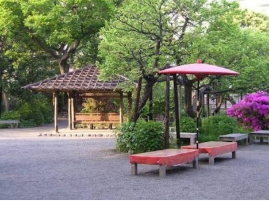Sumida river Shichifukujin (Seven Lucky Gods)

On the east bank of the Sumida River between Gongen-bashi Bridge and Suijin Ohashi Bridge, there is a quaint New Year’s event called the “Sumida River Seven Lucky Gods Tour” that has continued since the Edo period. If you start from the south, get off at Tokyo Skytree Station and go north from Mimeguri Shrine. If you start from the north, get off at Horikiri Station and go south from Tamonji Temple.
For detailed route information, please refer to the following website. http://tabi.tobu.co.jp/playing/hiking/town/sumidagawa/
三囲神社(Mimeguri Shrine) 2-5-17 Mukojima, Sumida-ku, Tokyo
The first two deities are “Daikokujin” and “Ebisujin” of Smimeguri Shrine.
In the style of the Seven Gods of Good Fortune, Daikokujin is Daikoku-sama, the god of fertility, and Ebisujin is Ebisu-san, the god of prosperous business.
弘福寺 (Kofukuji) 3-2, Mukojima 5-chome, Sumida-ku
The third deity is Hotei-sama, the God of Fortune, or “Hotei-son” at Kofukuji Temple. The third deity is Hotei, the God of Fortune, whose real name is Qi Konoh, a Zen monk of the Tang Dynasty in China. He is the only one of the Seven Gods of Good Fortune who actually existed. Kofukuji Temple is a branch temple of Manpukuji Temple, the head temple of the Obaku sect of Zen Buddhism, located in Uji, Kyoto. It is the Zen temple that Kaishu Katsu attended as a child.
長命寺(Chomeiji) 5-4-4 Mukojima, Sumida-ku, Tokyo
The fourth deity is Benzaiten, or Benten, the goddess of water, at Chomeiji Temple. The fourth deity is Benzaiten, the goddess of water, who is worshipped in many places related to water. As the character “財 zai” in her name indicates, she is also a goddess of treasure and good fortune.

向島百花園(Mukojima Hyakkaen) 3-18-3 Higashimukojima, Sumida-ku, Tokyo
The fifth deity is “Fukurokujuson” of Mukojima Hyakkaen Garden. Mukojima Hyakkaen is a garden built in 1804 during the Edo period. The most distinctive feature of this garden is that it is a “private garden” created by a single merchant, unrelated to the shogunate, feudal lords, shrines, or temples. In October 1978, the garden was designated by the national government as a place of scenic beauty and a historic site.
Sawara Kikuu, the founder of Hyakkaen, loved to keep Fukurokujuzon as the god of flowers and plants. That was the beginning of the Sumida River Seven Lucky Gods.

白鬚神社(Shirahige Shrine) 3-5-2, Higashimukojima, Sumida-ku, Tokyo
The sixth deity is the Jurojin of Shirahige Shrine. It was originally enshrined as a branch shrine from the head shrine of Shirahige Shrine, which is located on the shore of Lake Biwa in Takashima City, Shiga Prefecture, in the 5th year of the Tenryaku era (951). The shrine has been worshipped as the deity of the former Terashima-cho, Sumida-ku, Tokyo…present-day Higashimukojima, Sumida, Tsutsumidori, Kyoshima, Yahiro, Oshiage…etc. The main deity, Sarutahiko no Mikoto, is the god who guided the god Amateru Ninigi no Mikoto, who descended from the heavens. From there, he is worshipped as a god of safety in travel, traffic safety, prosperity in business, and protection against misfortune.

多聞寺(Tamonji) 31-13, Sumida 5-chome, Sumida-ku, Tokyo
The seventh and final deity is Bishamonten (Bishamonten) here at Tamonji Temple. The temple was built in the Tentoku era (957-960), and its principal deity is Bishamonten, said to have been created by Kobo Daishi. Bishamonten is a god of valor, and was worshipped by samurai warriors.





